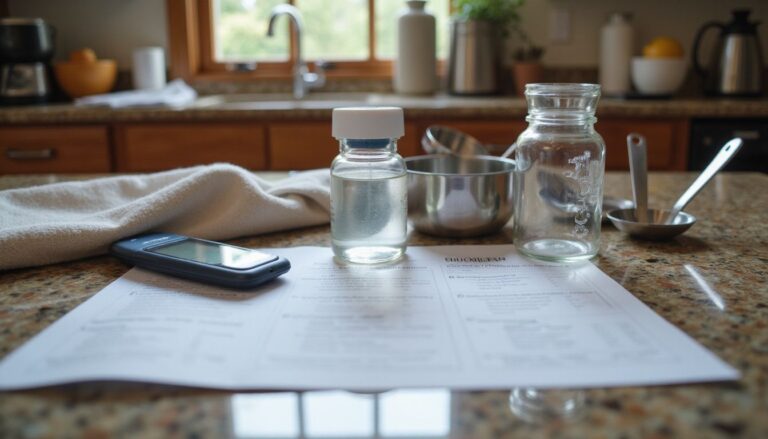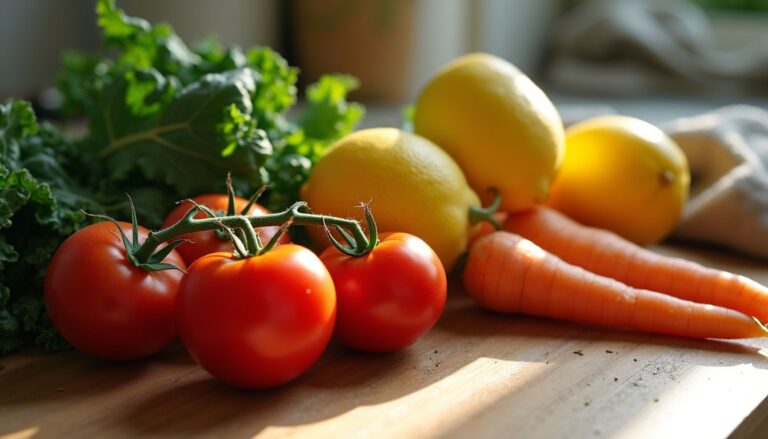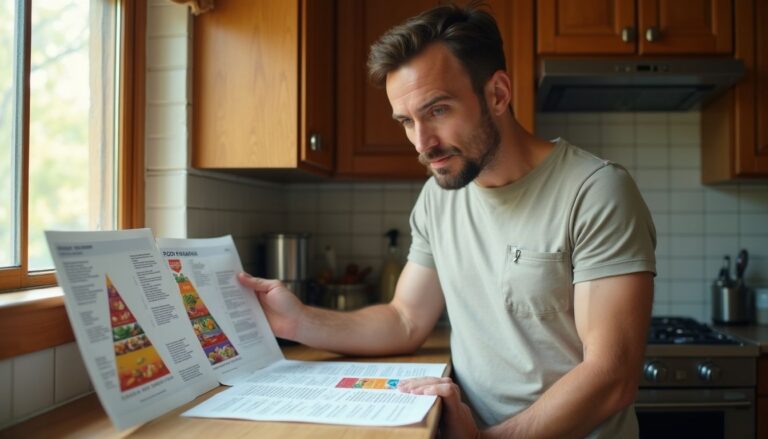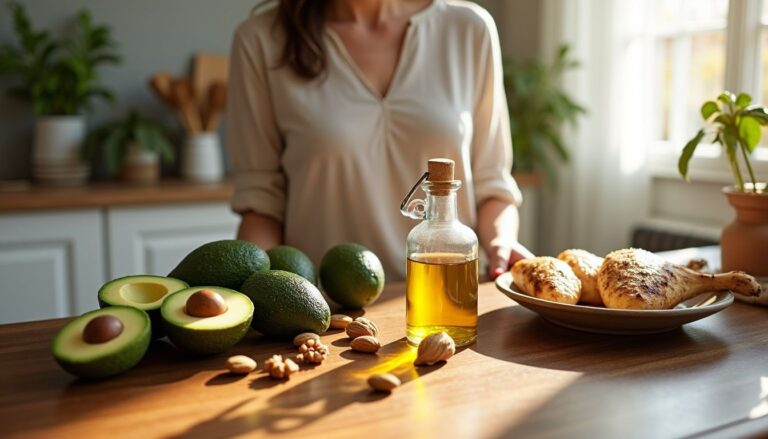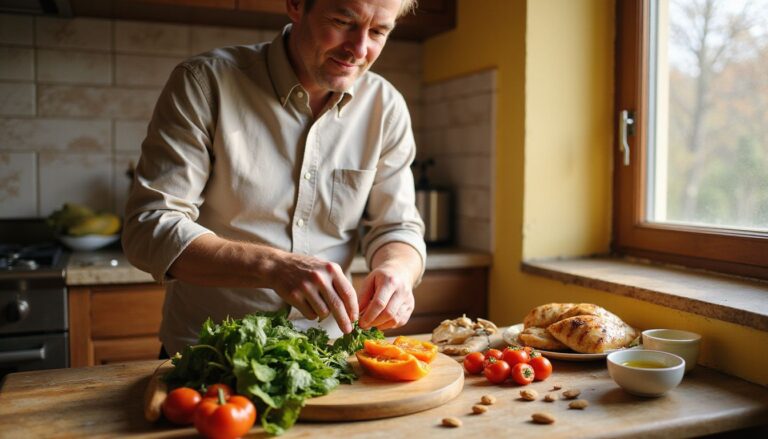7-Day Fat Loss Diet Plan For Female: Sample Meal Plan And Weight Loss Tips
Our Nutrition Assistant AI Suite will transform your body. You will lose fat, get toned, and build muscle. Gain confidence and optimal health.
Many women work hard to eat well yet still find losing weight frustrating. A focused fat loss diet plan can help by using balanced meals, simple habits, and a steady calorie deficit. This 7-day meal plan gives clear steps, practical tips, and safe targets so you can start strong and keep going.
Below you will find a complete 7-day meal plan, coaching on portions and macronutrients, and smart weight loss strategies. Small changes add up. With a bit of planning, you can build healthy routines that last.
Key Takeaways
- The 7-day fat loss diet plan for females centers on balanced meals, portion control, and whole foods to create a calorie deficit and support sustainable results.
- Women ages 19 to 50 with light activity often need about 1,800 to 2,200 calories daily. Many weight loss plans aim lower, for example near 1,200 calories, to speed progress.
- The Mayo Clinic Diet and USDA guidance suggest filling half your plate with fruits and vegetables, focusing on lean proteins, and limiting highly processed foods.
- A daily calorie reduction of 500 to 1,000 calories can lead to about 1 to 2 pounds of weekly weight loss, based on research.
- Tracking intake, getting about 2.7 liters of fluids per day, and adding regular exercise can improve diet adherence and long-term weight management.
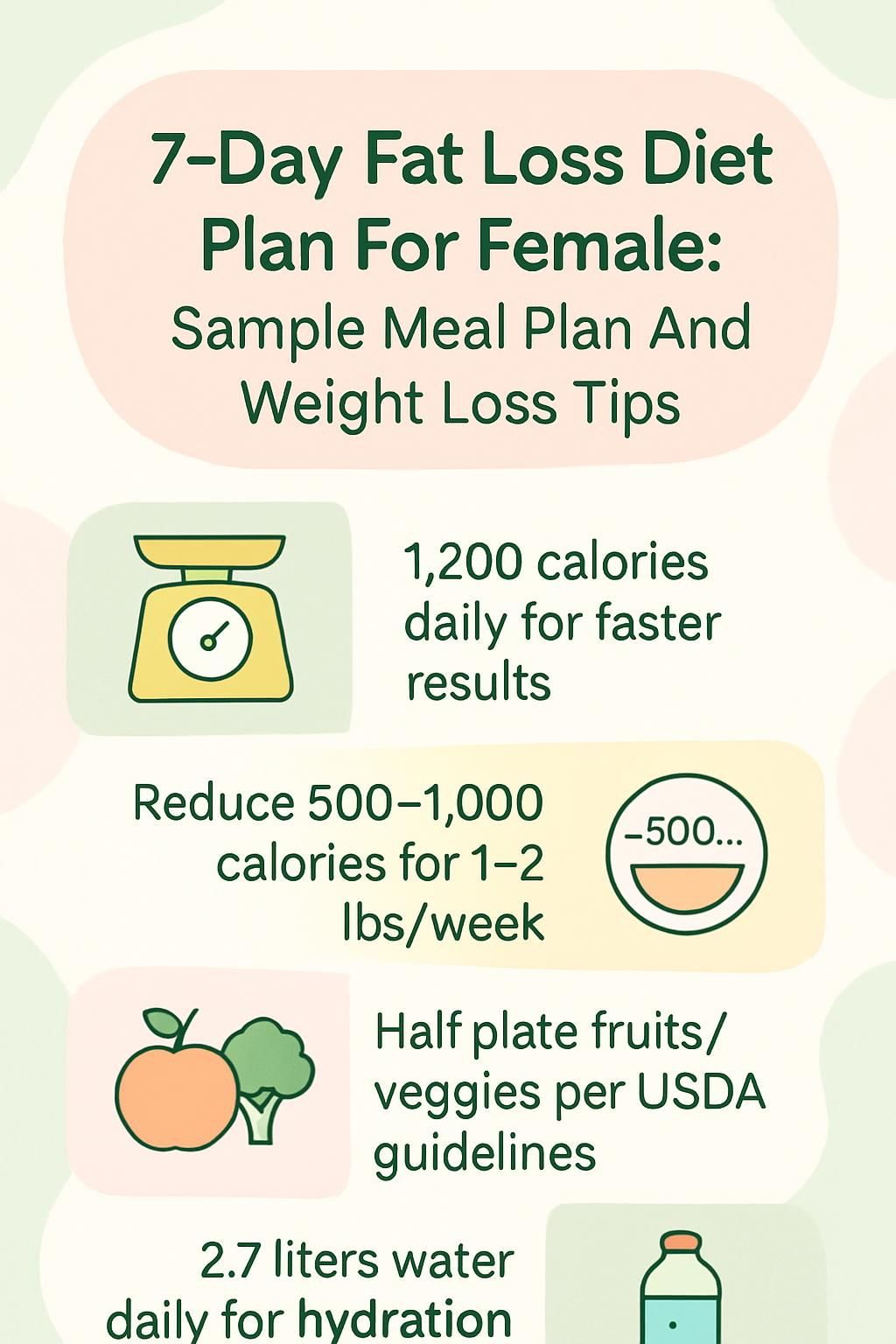
Understanding Fat Loss for Females
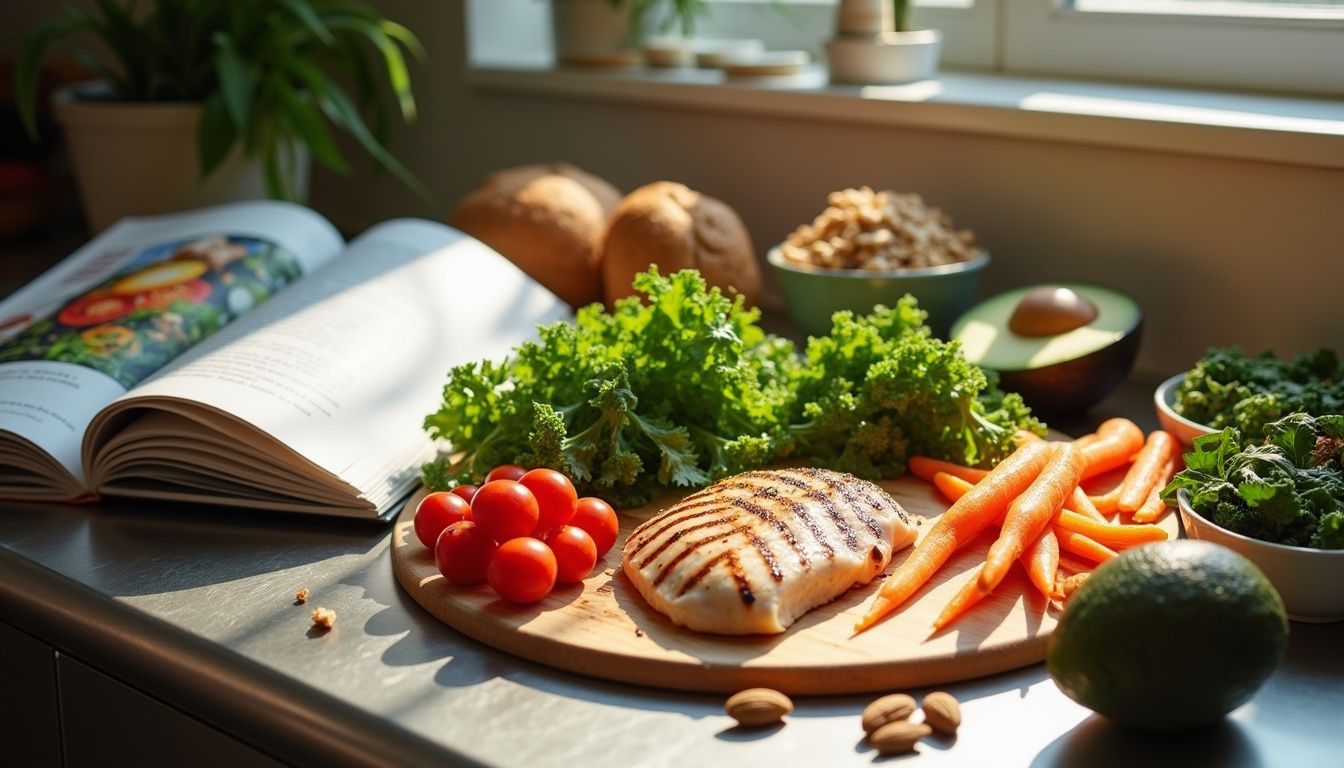
Women process calories and nutrients differently because of hormones, body composition, and unique health needs. Knowing these differences helps you build a diet meal plan that supports steady fat loss and better long-term health.
Why is diet important for fat loss?
Diet controls daily calorie intake, which directly affects fat loss. A calorie deficit happens when you eat fewer calories than your body uses. In that state, your body taps stored fat for energy.
The Mayo Clinic Diet encourages unlimited fruits and vegetables so you feel full on low-calorie, nutrient-rich foods rather than ultra-processed snacks or sugary desserts. That shift supports healthy weight management and may reduce risk for obesity, diabetes, and heart disease.
Build your plate with whole grains, lean protein like cottage cheese or fish, healthy fats such as almonds or olive oil, and high-fiber produce like spinach. These choices support metabolism and tame hunger.
Following guidelines becomes easier when you use simple meal plans that match your preferences. I found that balanced meals cut my late-night cravings, especially once I built a routine that fit my schedule.
“Healthy eating is the foundation of successful weight loss,” says Mayo Clinic experts.
Understanding calorie deficits and metabolism prepares you to create a smarter diet strategy.
How do calorie deficits and metabolism affect fat loss?
Eating fewer calories than you burn creates a calorie deficit. Your body then uses stored fat in adipose tissue for energy, which helps you lose weight.
Cutting 500 to 1,000 calories per day can support a loss of about 1 to 2 pounds per week, which aligns with the Mayo Clinic LIVE IT! phase and published studies.
Metabolism is how many calories your body uses at rest, called basal metabolic rate. Physical activity raises total calorie burn by engaging skeletal muscle. That is why movement makes fat loss more effective.
Estimating portions and choosing filling, low-calorie foods, such as those featured in the Healthy Weight Pyramid, support safe progress and help prevent regain.
Why do females need a tailored meal plan?
Women have unique needs that shape how the body responds to a calorie deficit. Hormones, body composition, and life stages like menstruation or pregnancy can change appetite and metabolism.
According to the 2020 to 2025 Dietary Guidelines for Americans, many women ages 19 to 50 who are lightly active need about 1,800 to 2,200 calories daily. Some plans, like the example by Betsy Farrell, target around 1,200 calories for faster fat loss.
Nutrient processing for protein, carbohydrates, and fats depends on muscle mass and reproductive health. Meal plans built for women can include dairy milk for calcium or beans for iron to support these needs.
Proper portion sizes help meet energy demands while covering micronutrients for blood pressure and bone strength. A registered dietitian can align your eating plan with your goals, especially if you have obesity or risk factors for cardiovascular disease.
Key Principles of a Fat Loss Diet Plan
A healthy weight loss plan uses clear rules to guide daily food choices. Balanced food groups and portion control help you hit your goals with less stress.
How to balance macronutrients for fat loss?
Each meal should include lean protein, complex carbohydrates, and healthy fats. Lean proteins like chicken, shrimp, or strained yogurt help you feel full and protect muscle during weight loss.
Pick whole grains such as brown rice or quinoa and fiber-rich vegetables like broccoli and lettuce to steady blood sugar and support gut bacteria. Use fats like olive oil, nut butter, or seeds for flavor and satisfaction while you reduce calories.
Balancing your plate with protein, fiber, and healthy fats makes nutritious eating simple and effective.
Aim for about 15 ounces of lean protein across your day. Add whole grains or oats at breakfast, and include fruit like berries or a banana. Use olive oil on salads for flavor and fullness.
Measuring cups and a food scale can make portions more accurate. That small step helped me reach weight loss targets sooner while keeping meals interesting and satisfying.
What is the role of portion control in weight loss?
Portion control helps you manage calories without counting every bite. The Mayo Clinic Diet teaches easy serving estimates, like 60 grams of whole-grain cereal or one cup of reduced-fat milk at breakfast.
Structured daily plans list amounts such as 30 grams of unsalted nuts or two slices of bread. These details simplify your routine and keep your eating plan on track.
The Mayo Clinic Healthy Weight Pyramid shows how foods fit into a balanced day. It also encourages flexible servings that match your eating style.
Smaller portions prevent overeating, even with healthy choices like berries or nuts. Sticking to set servings often beats guessing and supports steady results.
How to incorporate whole, nutrient-dense foods?
Begin your day with whole grains such as wheat toast or an English muffin. Add eggs, berries, or apple slices for protein and fiber.
At lunch and dinner, fill half your plate with vegetables like carrot sticks, tomatoes, roasted potatoes, or spinach salads. Choose lean proteins, including chicken, beans, or fish, in place of processed meats.
Snack on fruit, such as orange slices or a berry mix, and add a small handful of almonds for lasting energy. Vegetable sides like fresh salsa or a corn tortilla with beans can round out meals.
Swap candy and chocolate for a fruit salad at dessert. Choose water or unsweetened coffee over soda or juice to support fat loss.
Last summer, I replaced nightly ice cream with mixed fruit and a splash of vinegar for tang. Cravings faded within two weeks, and the extra produce kept me full with fewer calories.
Use these swaps to support weight loss while boosting nutrition and health.
Why is staying hydrated important during fat loss?
Fruits and vegetables add water to your diet, which supports digestion and helps you feel full. That can lower calorie intake across the day.
Drinking enough fluids supports the body’s metabolism and fat breakdown. This 7-day plan favors unsweetened drinks like water, reduced-fat milk, and yogurt.
Add water-rich foods, such as oranges and leafy salads, to meet fluid goals. The Department of Agriculture suggests women aim for about 2.7 liters of total water daily from food and drinks combined.
Hydration can boost exercise performance and reduce headaches or fatigue during weight loss. Coffee with reduced-fat milk at breakfast or snack time can fit into your fluid target while keeping calories modest.
A 7-Day Fat Loss Diet Plan for Females
This 7-day meal plan helps you make daily choices that support steady fat loss and better health. Each day includes simple meals with fiber, balanced macros, and easy prep.
Day 1: Sample Meal Plan
Day 1 sets the tone with balanced portions and whole foods. You will get lean protein, whole grains, produce, and healthy fats to keep energy stable.
- Eat breakfast of 1 apple, 1 tablespoon almond butter, 1 slice whole-grain toast, and 1 egg for protein, fiber, and healthy fat.
- Enjoy lunch with 2 cups mixed greens, 1 cup quinoa, 3 ounces grilled chicken, 2 teaspoons olive oil, vinegar, and spices.
- Have dinner with 4 ounces grilled shrimp, 1 cup stir-fried vegetables, and 1 cup brown rice for protein and fiber.
- Add half an orange as a snack to boost vitamin C and support digestion.
- Drink at least 8 cups of water to support hydration and appetite control.
- Limit candy and sweet baked goods to manage sugar and avoid extra calories.
- If vegetarian, replace chicken or shrimp with beans, tofu, or another plant protein.
- Choose whole grains like brown rice instead of white rice or refined bread for more fiber.
- Increase physical activity like walking, cycling, or light weights to burn more calories.
- Cook with roasting, grilling, or baking instead of frying to reduce added fat.
- Practice mindful portions to support a calorie deficit and long-term weight control.
On my first day using this plan, I felt energized and noticed fewer candy cravings because the meals were filling.
What should I eat for breakfast on Day 1?
Start with 1 egg for protein and healthy fats. Add 1 slice of whole-grain toast for fiber and steady energy. Spread 1 tablespoon of almond butter on the toast for extra flavor and heart-healthy fats.
Include 1 apple for vitamins and more fiber. This mix supports satiety through the morning. Research suggests a protein-rich breakfast improves fullness and weight loss adherence (Leidy et al., 2015). Choose water or unsweetened tea to hydrate without extra calories.
What is a good lunch option for Day 1?
Build a salad with 2 cups mixed greens, 1 cup cooked quinoa, and 3 ounces grilled chicken. Dress with 2 teaspoons olive oil, a splash of vinegar, and spices.
This meal delivers protein, fiber, and healthy fats for steady energy. It is about 330 calories and supports muscle recovery and digestion. Simple ingredients also keep prep stress low, which helps you stick with the plan.
What dinner supports fat loss on Day 1?
Choose 4 ounces of grilled shrimp for lean protein. Add 1 cup stir-fried vegetables for fiber and micronutrients, and 1 cup brown rice for slow-digesting carbs.
This balance supports fat loss without excess calories. I felt satisfied and energized when I used this combo for dinner. It provides protein, fiber, and complex carbs, a mix linked with successful fat loss in women.
Day 2: Sample Meal Plan
Day 2 keeps energy steady and supports weight loss with straightforward meals and hydration targets.
- Start with a smoothie using 1 cup unsweetened almond milk, 1 banana, and 1 tablespoon peanut butter for protein, potassium, and healthy fats.
- Make a lunch sandwich with two slices of whole-grain bread, 3 ounces turkey breast, lettuce, tomato, and 1 teaspoon mustard.
- Add raw carrot sticks or cucumber slices at lunch for fiber and crunch.
- For dinner, have 4 ounces baked tilapia, 1 cup steamed broccoli, and 1 medium sweet potato.
- Drink at least eight cups of water through the day to support metabolism.
- Limit high-sugar drinks and processed snacks that can slow progress.
The next section outlines Day 3 with new ideas to stay motivated.
What should I eat for breakfast on Day 2?
Blend 1 cup unsweetened almond milk, 1 banana, and 1 tablespoon peanut butter. This smoothie is about 250 calories and offers carbs, healthy fats, and protein.
The banana provides quick energy. Peanut butter adds satiety. If needed, add a slice of whole grain toast for extra fiber. This quick breakfast fits busy mornings and supports your plan.
What is a good lunch option for Day 2?
Use 2 slices of whole-grain bread and 3 ounces turkey. Add lettuce and tomato for fiber and volume. Spread 1 teaspoon mustard for flavor without many calories.
This lunch balances protein, carbs, and produce. Many women find a simple sandwich like this helps avoid afternoon snacking. Add cucumber slices on the side if you want more crunch.
What dinner supports fat loss on Day 2?
Choose 4 ounces baked tilapia for lean protein. Add 1 cup steamed broccoli for fiber and micronutrients. Include 1 medium sweet potato for complex carbs and vitamin A.
Season tilapia with lemon juice and herbs for taste without extra calories. Preparing the fish and broccoli ahead can make weeknights easier. This dinner fits a calorie deficit and helps curb evening cravings.
Day 3: Sample Meal Plan
Day 3 brings simple choices that support energy and fat loss without complicated prep.
- Breakfast: 1 cup oatmeal topped with 1 tablespoon honey and 1/2 cup mixed berries for fiber and natural sweetness.
- Lunch: Whole-wheat wrap with 3 ounces grilled chicken, 1/2 avocado, and vegetables like spinach or tomato.
- Dinner: 4 ounces beef stir-fry, 1 cup mixed vegetables, and 1/2 cup brown rice.
- Drink 8 to 10 cups of water to support appetite control and metabolism.
- Avoid sugary drinks and highly processed foods that can slow fat loss.
- Use a kitchen scale or measuring cups for accurate portions.
- Track meals in a food diary or app to stay consistent.
- Walk at least 30 minutes after lunch or dinner to increase calorie burn.
- Snack on raw veggies or a small handful of nuts if hungry between meals.
- I used a similar plan for a week and felt less bloated, more energized, and slept better.
- Keep meals simple and whole-food based to support your health and fat loss goals.
What should I eat for breakfast on Day 3?
Have 1 cup of cooked oatmeal. Top with 1 tablespoon honey and 1/2 cup mixed berries like blueberries or strawberries.
This breakfast supplies fiber for fullness and slow-release energy. The berries add antioxidants and vitamins that support your plan.
What is a good lunch option for Day 3?
Fill a whole-wheat wrap with 3 ounces grilled chicken for lean protein. Add 1/2 avocado for healthy fats and creamy texture. Pile on spinach, tomatoes, and bell peppers for fiber and color.
This lunch delivers protein, healthy fat, and whole grains to keep you full longer. It also supports your metabolism through the afternoon.
What dinner supports fat loss on Day 3?
Choose 4 ounces beef stir-fry with 1 cup mixed vegetables like bell peppers and broccoli. Add 1/2 cup brown rice for steady energy.
This balanced dinner supports muscle while you are in a calorie deficit. It is satisfying, nutrient dense, and easy to repeat later in the week.
Day 4: Sample Meal Plan
Day 4 focuses on balanced meals and smart portions to keep hunger in check and energy up.
- Breakfast: 1 cup low-sugar granola with 6 ounces plain yogurt for fiber and protein.
- Lunch: 1 cup tomato soup plus a mini whole-wheat pita with 3 ounces roast beef, tomato, lettuce, horseradish, and mustard. Add 2 cups raw vegetables with 1/4 cup hummus.
- Dinner: 4 ounces poached salmon, 1.25 cups coleslaw with rice vinegar and olive oil, and 1 cup quinoa.
- Drink at least eight cups of water to support hydration and metabolism.
- Stick to meal times to reduce mindless snacking.
- Meal prep when busy to control portions and keep ingredients fresh.
- Tracking food on days like Day 4 or Day 5 helped me stay consistent.
- Fill at least half your plate with vegetables at lunch and dinner.
Next, see what Day 5 includes and how it supports your fat loss plan.
What should I eat for breakfast on Day 4?
Choose 1 cup low-sugar granola with 6 ounces plain yogurt. This mix offers protein and fiber that support satiety until lunch.
Starting the day with this combo gave me steady energy without a sugar crash. Drink water with breakfast to support digestion and hydration.
What is a good lunch option for Day 4?
Make a mini whole-wheat pita with 3 ounces roast beef, horseradish, mustard, tomato, and lettuce. Pair with 1 cup tomato soup.
Add 2 cups raw vegetables and 1/4 cup hummus for crunch and fiber. This balanced lunch keeps calories reasonable while covering protein, produce, and whole grains.
What dinner supports fat loss on Day 4?
Eat 4 ounces poached salmon for protein and omega-3 fats. Add 1.25 cups coleslaw with rice vinegar and a little olive oil, plus 1 cup cooked quinoa.
This meal supports fullness, heart health, and steady energy. I felt more satisfied at dinner and had fewer late-night cravings with a similar setup.
Day 5: Sample Meal Plan
Day 5 keeps meals nutrient dense and satisfying without feeling restrictive.
- Breakfast: 1 cup Cheerios with 1/2 cup berries, 1 tablespoon slivered almonds, and 6 ounces Greek yogurt.
- Lunch: Mushroom quesadilla with cucumber spears. Add 1/2 cup cottage cheese or Greek yogurt for extra protein.
- Snack: Two clementines for a sweet, vitamin C rich option.
- Dinner: Pork tenderloin finished with balsamic glaze, about 370 calories per serving, with roasted butternut squash.
- Drink water with each meal to support hydration and metabolism.
- Measure ingredients to keep a healthy calorie deficit.
- Include lean proteins, produce, and whole grains to support long-term health goals.
What should I eat for breakfast on Day 5?
Start with 1 cup Cheerios and 1/2 cup fresh berries for fiber and antioxidants. Add 1 tablespoon slivered almonds for healthy fats and crunch.
Pair with 6 ounces Greek yogurt for protein that supports muscle during fat loss. This breakfast is simple, filling, and easy to prep.
What is a good lunch option for Day 5?
Choose mushroom quesadillas for lunch. Add crisp cucumber spears for hydration and fiber. Include 1/2 cup cottage cheese or Greek yogurt plus two clementines for protein and vitamin C.
This balanced meal kept me full until dinner without heavy feelings or cravings.
What dinner supports fat loss on Day 5?
Pick pork tenderloin with a light balsamic glaze, about 370 calories per serving. Pair with roasted butternut squash for fiber and vitamins A and C.
Eat dinner two to three hours before bed to support digestion. Prepping tenderloin helped me control portions, and roasting squash made dinner easy and tasty.
Day 6: Sample Meal Plan
Day 6 highlights balanced nutrition, portion control, and volume-rich foods that keep you full on fewer calories.
- Breakfast: One whole-grain frozen waffle topped with 2 tablespoons nut butter and one sliced banana, plus 8 ounces fat-free milk.
- Lunch: Tuna salad made with low-fat mayo or plain Greek yogurt, about 135 calories per serving, with 10 baby carrots, two-thirds cup Greek yogurt, and a fresh pear.
- Dinner: Sausage jambalaya with 3 cups spinach sautéed in olive oil.
- Choose snacks like plain popcorn or apple slices if hunger appears between meals.
- Drink at least eight glasses of water across the day.
- Limit sugar-sweetened drinks and processed snacks that add empty calories.
- Track meals with a journal or app to spot patterns and stay accountable.
What should I eat for breakfast on Day 6?
Toast one whole-grain frozen waffle. Spread 2 tablespoons nut butter, then layer one sliced banana. Sprinkle cinnamon and nutmeg for flavor without added sugar.
Pour an 8-ounce glass of fat-free milk for protein and calcium. This combo kept me satisfied until lunch on busy mornings.
What is a good lunch option for Day 6?
Make tuna salad with low-fat mayo or yogurt, about 135 calories per serving. Add 10 baby carrots for crunch and fiber. Include two-thirds cup Greek yogurt for extra protein and a fresh pear for natural sweetness.
This lunch balances lean protein, dairy, vegetables, and fruit to support steady fat loss.
What dinner supports fat loss on Day 6?
Serve sausage jambalaya with 3 cups sautéed spinach in olive oil. Protein from sausage and fiber from spinach promote fullness while controlling calories.
Spinach provides vitamins A and C, iron, and magnesium. I found this meal satisfying yet light enough to avoid late-night hunger. Flavorful dishes like these make a 7-day plan easier to follow.
Day 7: Sample Meal Plan
Finish strong on Day 7 with wholesome meals that keep energy steady and cravings low.
- Breakfast: Half an English muffin with 1 ounce reduced-fat cheese, steamed spinach, sliced tomato, and a poached egg. Add half a grapefruit.
- Lunch: Black bean salad with 1/2 cup canned black beans, chopped orange segments, diced red bell pepper, slivered red onion, scallions, and salad greens.
- Add one corn tortilla at lunch for complex carbs that fuel activity.
- Snack on fresh fruit in the afternoon for sweetness and micronutrients.
- Dinner: Grilled white fish or skinless chicken breast with roasted broccoli and carrots. Use lemon juice or spices instead of creamy sauces.
- Drink at least eight cups of water through the day to support appetite control.
- Limit processed snacks high in added sugar or salt. Choose whole foods whenever possible.
Balanced planning like this helped me lower body fat during a busy college season while keeping energy high for training.
What should I eat for breakfast on Day 7?
Top half an English muffin with 1 ounce reduced-fat cheese and sliced tomato. Add steamed spinach, then a poached egg for high-quality protein.
Include half a grapefruit for vitamin C and hydration. This balanced meal promotes fullness and steady energy.
What is a good lunch option for Day 7?
Build a black bean salad with 1/2 cup canned black beans, chopped orange, red bell pepper, red onion, and scallions over salad greens. Include a small corn tortilla on the side for whole grains.
Finish with fruit like berries or apple slices. This plant-forward lunch offers protein, fiber, and slow-digesting carbs for steady energy.
What dinner supports fat loss on Day 7?
Choose grilled salmon for protein and omega-3 fats. Add a large serving of steamed broccoli or spinach and 1/2 cup quinoa for slow-release carbs.
Drizzle vegetables with 1 teaspoon olive oil. Drink water or unsweetened herbal tea. Season with lemon juice, garlic, or herbs instead of heavy sauces. This dinner is about 400 to 500 calories and includes around 30 grams of protein.
Tips for Successful Fat Loss
These practical tips help you stay on track and build progress you can see and feel.
How can regular physical activity aid fat loss?
Exercise increases calorie burn, which makes fat loss easier. The Mayo Clinic Diet suggests at least 30 minutes of daily activity for weight management. Federal dietary guidelines and cancer prevention groups support regular movement for better weight control.
If you have been inactive or have medical concerns, start small and build up gradually. An exercise journal and weight tracker can boost motivation. On active days, your body uses more energy, which over time may lower body fat. Activity also improves mood and energy.
What is mindful eating and how does it help?
Mindful eating means paying attention while you eat, without screens or distractions. You slow down, taste your food, and check in with hunger and fullness.
Research suggests mindful eating can reduce overeating and improve weight control. Try eating at the table, putting away devices, and savoring each bite. Turning off the TV at dinner helped me enjoy meals more and avoid seconds.
Greater awareness makes it easier to stick to your goals and choose foods that serve your plan.
Why avoid high-sugar and processed foods?
High-sugar and ultra-processed foods add calories fast and do little for satiety. They can spike blood sugar, increase cravings, and raise risks for obesity, heart disease, and type 2 diabetes.
Limit desserts to about 75 calories per day in a weekly budget if you want a small treat. Shifting away from packaged foods often improves cholesterol and blood pressure and supports steady weight loss. Whole, nutrient-dense foods keep you full longer and deliver the vitamins your body needs.
How to track progress without obsessing over the scale?
Track habits, not just weight. The Mayo Clinic Diet includes a weight tracker along with habit tools like veggie intake and water goals.
Log days you meet targets for portions and activity. Notice energy, mood, clothing fit, and sleep. Set non-scale goals such as cooking at home three nights per week or walking 8,000 steps a day.
People who track habits often feel more successful and maintain loss longer. Focus on routines you can keep rather than day-to-day fluctuations on the scale.
Foods to Include and Avoid
Choosing the right foods helps you manage calories, hunger, and nutrition at the same time.
What are the best foods to include for fat loss?
Pick foods that support satiety, provide key nutrients, and fit your calorie target. Favor options high in fiber and lean protein.
- Vegetables: Load up on non-starchy veggies like spinach, broccoli, carrots, and bell peppers. They add fiber and volume with few calories.
- Fruits: Enjoy fruit for natural sweetness and nutrients. Berries, apples, and oranges offer vitamins and antioxidants.
- Whole Grains: Choose brown rice, quinoa, oats, or whole wheat bread for lasting energy and more fiber than refined grains.
- Lean Proteins: Include eggs, fish, chicken breast, beans, and tofu to maintain muscle and manage hunger.
- Nuts and Seeds: Add almonds, walnuts, chia, or sunflower seeds for healthy fats and a protein boost. Keep portions small.
- Beans and Legumes: Lentils, chickpeas, and black beans provide fiber and protein for fullness and heart health.
- Fish: Eat salmon or tuna twice a week for omega-3 fats and protein, which may support weight control.
- Healthy Fats: Use avocado and olive oil to aid vitamin absorption and hormone health. Keep servings modest.
- Water: Drink water throughout the day to help manage appetite and support metabolism.
- Minimally Processed Foods: Choose items with few added ingredients to reduce extra sugar and sodium.
Which foods should be avoided for effective fat loss?
Certain foods make calorie control harder and can stall progress. Cutting back on these choices can help your plan work better.
- High-sugar snacks and desserts, such as candy bars and packaged pastries.
- Processed foods like chips, crackers, instant noodles, and many frozen dinners.
- Sweetened drinks, including soda, energy drinks, flavored coffees, and sweet teas.
- Deep-fried items, such as fries or fried chicken, which are high in saturated fat.
- Baked goods like muffins, doughnuts, and croissants with lots of sugar and unhealthy fats.
- Keep sweets near 75 calories per day if you want a small treat.
- Fatty cuts of meat and highly processed meats like sausages or bacon.
- Sugary cereals that spike blood sugar and leave you hungry soon after.
Cutting soda made the biggest difference for me. Removing just one can per day sped up my progress without feeling deprived.
Common Pitfalls and How to Avoid Them
Small mistakes can stall results. Knowing the traps helps you prevent them and keep momentum.
How can overeating healthy foods hinder fat loss?
Eating large portions of healthy foods can still slow fat loss if calories exceed your needs. Natural fruit sugar can raise blood sugar if you eat more than your body is used to.
High-fiber foods can also cause stomach discomfort when eaten in very large amounts at once. Portion control still matters with nuts, whole grains, and avocados. For example, a cup of cooked brown rice has about 215 calories, and a medium avocado has more than 230 calories.
Extra helpings can cancel your deficit. Keep an eye on portions, even with nutrient-rich foods.
Why is skipping meals a problem for fat loss?
Skipping meals can lead to extreme hunger and overeating later in the day. You may end up choosing foods high in sugar and fat and eating more than planned.
Irregular eating can reduce energy and make your plan harder to follow. Balanced meals and scheduled snacks support metabolism and make workouts or daily tasks feel easier.
How to set realistic expectations for weight loss?
Use data-backed targets. In the LOSE IT! phase, you may lose 6 to 10 pounds over two weeks. After that, in LIVE IT!, aim for about 1 to 2 pounds per week.
Focus on gradual change and celebrate small wins. I once set a goal to lose ten pounds in one week and felt discouraged. Changing to realistic targets helped me stay motivated and consistent.
Maintaining Long-Term Weight Loss
Long-term success comes from habits you can keep. Build routines that support health in daily life.
How to build sustainable fat loss habits?
Start small with changes you can live with. The LIVE IT! phase emphasizes portion control and smart food choices, day after day.
Pick habits that feel positive, not restrictive. Include movement that fits your schedule. Research shows routines built this way are more likely to last and support healthy weight. Celebrate small wins to reinforce confidence.
When and how to adjust your diet plan?
Watch your weight trend, energy, and activity level. Adjust if progress stalls, you feel overly tired, or your health needs change.
People with diabetes may prioritize vegetables over fruit and should speak with a healthcare professional before major changes. If you move more, increase calories slightly. Many women do well between 1,200 and 1,800 calories depending on activity.
Swap meals to match taste while cutting processed foods and adding whole grains. Do not rely only on the scale. Track clothing fit, strength, and energy. If you have medical conditions, consult a professional before changing your plan.
Why prioritize overall health and well-being?
Adjustments keep you on track, but focusing on whole-body health creates lasting change. Weight loss can help manage diabetes, heart disease, high blood pressure, and sleep apnea. The Mayo Clinic Diet takes this broad approach to protect you from weight-related problems.
Chasing a number on the scale can miss the bigger picture. I felt better and slept more easily when I switched to balanced meals instead of crash diets. Paying attention to how you feel helps you build skills for long-term success.
Conclusion
This 7-day fat loss diet plan for females offers a simple path to start your weight loss journey. Balanced meals, smart portions, and a realistic calorie deficit can help you lose fat while still getting the nutrients you need. Hydration supports appetite control and metabolism, and mindful eating prevents overeating.
Pair your eating plan with regular physical activity for better results. Limit processed foods and added sugars to keep momentum. Consistent, manageable habits, as modeled in the Mayo Clinic Diet, support lasting weight management and better health over time.
Medical disclaimer: This guide is educational and does not replace personalized medical advice. If you have diabetes, heart disease, or another condition, consult a registered dietitian or healthcare provider before changing your diet or exercise plan.
FAQs
1. What is a 7-day fat loss diet plan for women and how does it work?
A 7-day fat loss eating schedule for women is a structured guide that outlines balanced meals and snacks over one week. It focuses on calorie control, nutrient-dense foods, and portion management. Studies show that following a planned menu can help reduce body fat while supporting muscle retention.
2. Can I lose weight by following the sample meal plan?
Research indicates that women who follow a calorie-controlled meal schedule with lean proteins, whole grains, fruits, and vegetables often see weight reduction within the first week. Results vary based on starting weight, activity level, and adherence to the plan.
3. What foods should I include or avoid in my fat loss meal schedule?
Include lean poultry, fish, legumes, leafy greens, whole grains, berries, and nuts. Limit processed foods high in sugar or saturated fat. Data from nutrition studies suggest that eating more fiber-rich foods helps control hunger and supports steady weight reduction.
4. Are there tips to make the weight reduction process easier during the 7-day plan?
Yes; drink water before meals to reduce appetite. Prepare meals ahead of time to avoid unhealthy choices. Track your food intake using an app or journal. A personal note: planning my weekly menu in advance helped me stay consistent with my goals. Research supports that meal planning increases the chance of long-term success.
Summary:
A well-structured 7-day fat loss eating schedule for women uses evidence-based strategies such as calorie control and nutrient-rich foods. Following these guidelines can support healthy weight reduction while promoting lasting habits.


